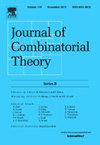Kővári-Sós-Turán theorem for hereditary families
IF 1.2
1区 数学
Q1 MATHEMATICS
引用次数: 0
Abstract
The celebrated Kővári-Sós-Turán theorem states that any n-vertex graph containing no copy of the complete bipartite graph has at most edges. In the past two decades, motivated by the applications in discrete geometry and structural graph theory, a number of results demonstrated that this bound can be greatly improved if the graph satisfies certain structural restrictions. We propose the systematic study of this phenomenon, and state the conjecture that if H is a bipartite graph, then an induced H-free and -free graph cannot have much more edges than an H-free graph. We provide evidence for this conjecture by considering trees, cycles, the cube graph, and bipartite graphs with degrees bounded by k on one side, obtaining in all the cases similar bounds as in the non-induced setting. Our results also have applications to the Erdős-Hajnal conjecture, the problem of finding induced -free subgraphs with large degree and bounding the average degree of -free graphs which do not contain induced subdivisions of a fixed graph.
Kővári-Sós-Turán世袭家族定理
著名的Kővári-Sós-Turán定理指出,任何不包含完全二部图Ks,s副本的n顶点图最多有Os(n2−1/s)条边。近二十年来,由于在离散几何和结构图理论中的应用,许多结果表明,如果图满足一定的结构限制,则该界可以得到很大的改进。我们对这一现象进行了系统的研究,并提出了一个猜想,即如果H是二部图,则诱导出的无H图和无k,s图不能比无H图有更多的边。我们通过考虑树、环、立方体图和二部图来证明这一猜想,在所有情况下都得到了与非诱导设置相似的界。我们的结果也适用于Erdős-Hajnal猜想、寻找大程度的诱导无c4子图的问题以及不包含固定图的诱导细分的Ks,s-free图的平均度的边界问题。
本文章由计算机程序翻译,如有差异,请以英文原文为准。
求助全文
约1分钟内获得全文
求助全文
来源期刊
CiteScore
2.70
自引率
14.30%
发文量
99
审稿时长
6-12 weeks
期刊介绍:
The Journal of Combinatorial Theory publishes original mathematical research dealing with theoretical and physical aspects of the study of finite and discrete structures in all branches of science. Series B is concerned primarily with graph theory and matroid theory and is a valuable tool for mathematicians and computer scientists.

 求助内容:
求助内容: 应助结果提醒方式:
应助结果提醒方式:


